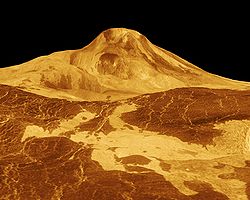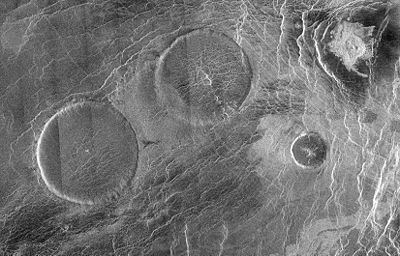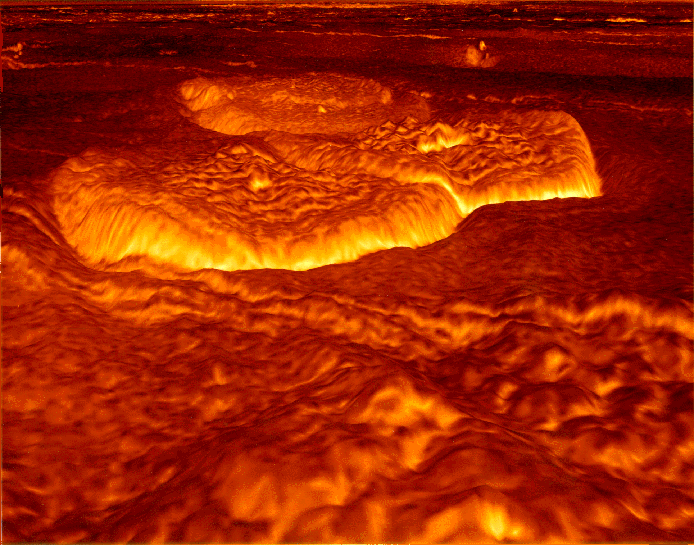
Volcanism on Venus
Encyclopedia

Venus
Venus is the second planet from the Sun, orbiting it every 224.7 Earth days. The planet is named after Venus, the Roman goddess of love and beauty. After the Moon, it is the brightest natural object in the night sky, reaching an apparent magnitude of −4.6, bright enough to cast shadows...
is dominated by volcanism
Volcanism
Volcanism is the phenomenon connected with volcanoes and volcanic activity. It includes all phenomena resulting from and causing magma within the crust or mantle of a planet to rise through the crust and form volcanic rocks on the surface....
and has produced more volcanoes than any other planet
Planet
A planet is a celestial body orbiting a star or stellar remnant that is massive enough to be rounded by its own gravity, is not massive enough to cause thermonuclear fusion, and has cleared its neighbouring region of planetesimals.The term planet is ancient, with ties to history, science,...
in the solar system
Solar System
The Solar System consists of the Sun and the astronomical objects gravitationally bound in orbit around it, all of which formed from the collapse of a giant molecular cloud approximately 4.6 billion years ago. The vast majority of the system's mass is in the Sun...
. It has a surface that is 90% basalt
Basalt
Basalt is a common extrusive volcanic rock. It is usually grey to black and fine-grained due to rapid cooling of lava at the surface of a planet. It may be porphyritic containing larger crystals in a fine matrix, or vesicular, or frothy scoria. Unweathered basalt is black or grey...
, and about 80% of the planet consists of a mosaic of volcanic lava
Lava
Lava refers both to molten rock expelled by a volcano during an eruption and the resulting rock after solidification and cooling. This molten rock is formed in the interior of some planets, including Earth, and some of their satellites. When first erupted from a volcanic vent, lava is a liquid at...
plains, indicating that volcanism played a major role in shaping its surface. The planet may have had a major global resurfacing event about 500 million years ago, from what scientists can tell from the density of impact craters on the surface. Even though there are over 1,600 major volcanoes on Venus, none is known to be erupting at present and most are probably long extinct. However, radar
Radar
Radar is an object-detection system which uses radio waves to determine the range, altitude, direction, or speed of objects. It can be used to detect aircraft, ships, spacecraft, guided missiles, motor vehicles, weather formations, and terrain. The radar dish or antenna transmits pulses of radio...
sounding by the Magellan probe
Magellan probe
The Magellan spacecraft, also referred to as the Venus Radar Mapper, was a 1,035-kilogram robotic space probe launched by NASA on May 4, 1989, to map the surface of Venus using Synthetic Aperture Radar and measure the planetary gravity...
revealed evidence for comparatively recent volcanic activity at Venus
Venus
Venus is the second planet from the Sun, orbiting it every 224.7 Earth days. The planet is named after Venus, the Roman goddess of love and beauty. After the Moon, it is the brightest natural object in the night sky, reaching an apparent magnitude of −4.6, bright enough to cast shadows...
's highest volcano Maat Mons
Maat Mons
Maat Mons is a massive shield volcano and the highest volcano on the planet Venus. It rises above the mean planetary radius at . It is named after the Egyptian goddess of truth and justice, Ma'at.-Structure:...
, in the form of ash
Volcanic ash
Volcanic ash consists of small tephra, which are bits of pulverized rock and glass created by volcanic eruptions, less than in diameter. There are three mechanisms of volcanic ash formation: gas release under decompression causing magmatic eruptions; thermal contraction from chilling on contact...
flows near the summit and on the northern flank.
Although many lines of evidence suggest that Venus is likely to be volcanically active, present-day eruptions at Maat Mons have not been confirmed. In April 2010, Suzanne E. Smrekar et al. announced the discovery of three active volcanoes, which suggests that Venus is periodically resurfaced by lava flows.
Venus contains shield volcano
Shield volcano
A shield volcano is a type of volcano usually built almost entirely of fluid lava flows. They are named for their large size and low profile, resembling a warrior's shield. This is caused by the highly fluid lava they erupt, which travels farther than lava erupted from more explosive volcanoes...
es, widespread lava flow
Lava
Lava refers both to molten rock expelled by a volcano during an eruption and the resulting rock after solidification and cooling. This molten rock is formed in the interior of some planets, including Earth, and some of their satellites. When first erupted from a volcanic vent, lava is a liquid at...
s and some unusual volcanoes called pancake dome
Pancake dome
A pancake dome, also known as a lava dome, is an unusual type of volcano found on the planet Venus. They are widely scattered on that planet and often form groups or clusters, though with smaller numbers of pancake domes in each group than is typical for the more common shield volcanos...
s and "tick-like" structures which are not present on Earth
Earth
Earth is the third planet from the Sun, and the densest and fifth-largest of the eight planets in the Solar System. It is also the largest of the Solar System's four terrestrial planets...
. Pancake dome volcanoes are up to 15 km (9.3 mi) in diameter and less than 1 km (0.621372736649807 mi) in height and are 100 times larger than those formed on Earth. They are usually associated with coronae and tesserae (large regions of highly deformed terrain, folded and fractured in two or three dimensions, believed to be unique to Venus). The pancakes are thought to be formed by highly viscous, silica-rich lava erupting under Venus's high atmospheric pressure.
The "tick-like" structures are called scalloped margin dome
Scalloped margin dome
A scalloped margin dome is a volcanic dome that has experienced collapse and mass wasting such as landslides on its perimeter. The margins of these domes have headscarps or 'scallops' separated by ridges that are a consequence of adjoining scallops. Sometimes debris or slumping can be found at...
s. They are commonly called ticks because they appear as domes with numerous legs. They are thought to have undergone mass wasting events such as landslides on their margins. Sometimes deposits of debris can be seen scattered around them.

Shield volcano
A shield volcano is a type of volcano usually built almost entirely of fluid lava flows. They are named for their large size and low profile, resembling a warrior's shield. This is caused by the highly fluid lava they erupt, which travels farther than lava erupted from more explosive volcanoes...
es and composite or stratovolcano
Stratovolcano
A stratovolcano, also known as a composite volcano, is a tall, conical volcano built up by many layers of hardened lava, tephra, pumice, and volcanic ash. Unlike shield volcanoes, stratovolcanoes are characterized by a steep profile and periodic, explosive eruptions...
es. The shield volcanoes, for example those in Hawaii
Hawaii
Hawaii is the newest of the 50 U.S. states , and is the only U.S. state made up entirely of islands. It is the northernmost island group in Polynesia, occupying most of an archipelago in the central Pacific Ocean, southwest of the continental United States, southeast of Japan, and northeast of...
, eject magma
Magma
Magma is a mixture of molten rock, volatiles and solids that is found beneath the surface of the Earth, and is expected to exist on other terrestrial planets. Besides molten rock, magma may also contain suspended crystals and dissolved gas and sometimes also gas bubbles. Magma often collects in...
from the depths of the Earth in zones called hot spot
Hotspot (geology)
The places known as hotspots or hot spots in geology are volcanic regions thought to be fed by underlying mantle that is anomalously hot compared with the mantle elsewhere. They may be on, near to, or far from tectonic plate boundaries. There are two hypotheses to explain them...
s. The lava from these volcanos is relatively fluid and permits the escape of gases. Composite volcanos, such as Mount Saint Helens and Mount Pinatubo
Mount Pinatubo
Mount Pinatubo is an active stratovolcano located on the island of Luzon, near the tripoint of the Philippine provinces of Zambales, Tarlac, and Pampanga. It is located in the Tri-Cabusilan Mountain range separating the west coast of Luzon from the central plains, and is west of the dormant and...
, are associated with tectonic plates. In this type of volcano, the oceanic crust
Oceanic crust
Oceanic crust is the part of Earth's lithosphere that surfaces in the ocean basins. Oceanic crust is primarily composed of mafic rocks, or sima, which is rich in iron and magnesium...
of one plate is sliding underneath the other in a subduction zone, together with an inflow of seawater, producing a gummier lava that restricts the exit of the gases, and for that reason, composite volcanoes tend to erupt more violently.
On Venus, where there are no tectonic plates
Plate tectonics
Plate tectonics is a scientific theory that describes the large scale motions of Earth's lithosphere...
or seawater
Seawater
Seawater is water from a sea or ocean. On average, seawater in the world's oceans has a salinity of about 3.5% . This means that every kilogram of seawater has approximately of dissolved salts . The average density of seawater at the ocean surface is 1.025 g/ml...
, volcanoes are mostly of the shield type. Nevertheless, the morphology of volcanoes on Venus is different: on Earth, shield volcanoes can be a few tens of kilometres wide and up to 10 km (6.2 mi) high in the case of Mauna Kea
Mauna Kea
Mauna Kea is a volcano on the island of Hawaii. Standing above sea level, its peak is the highest point in the state of Hawaii. However, much of the mountain is under water; when measured from its oceanic base, Mauna Kea is over tall—significantly taller than Mount Everest...
, measured from the sea floor. On Venus, these volcanoes can cover hundreds of kilometres in area, but they are relatively flat, with an average height of 1.5 km (0.93205910497471 mi). Large volcanoes causes the Venusian lithosphere to flex downward because of their enormous vertical loads, producing flexural moats and/or ring fractures around the edifices [McGovern and Solomon, 1998]. Large volcano edifice loading also causes magma chambers to fracture in a sill-like pattern, affecting magma propagation beneath the surface.

Dike (geology)
A dike or dyke in geology is a type of sheet intrusion referring to any geologic body that cuts discordantly across* planar wall rock structures, such as bedding or foliation...
s or graben
Graben
In geology, a graben is a depressed block of land bordered by parallel faults. Graben is German for ditch. Graben is used for both the singular and plural....
s) and arachnoid
Arachnoid (astrogeology)
In astrogeology, an arachnoid is a large structure of unknown origin, and they have been found only on the surface of the planet Venus. Arachnoids get their name from their resemblance to spider webs. They appear as concentric ovals surrounded by a complex network of fractures, and can span 200...
s. A nova is formed when large quantities of magma are extruded onto the surface to form radiating ridges and trenches which are highly reflective to radar. These dikes form a symmetrical network around the central point where the lava emerged, where there may also be a depression caused by the collapse of the magma chamber
Magma chamber
A magma chamber is a large underground pool of molten rock found beneath the surface of the Earth. The molten rock in such a chamber is under great pressure, and given enough time, that pressure can gradually fracture the rock around it creating outlets for the magma...
.
Arachnoids are so named because they resemble a spider's web, featuring several concentric ovals surrounded by a complex network of radial fractures similar to those of a nova. It is not known whether the 250 or so features identified as arachnoids actually share a common origin, or are the result of different geological processes.


